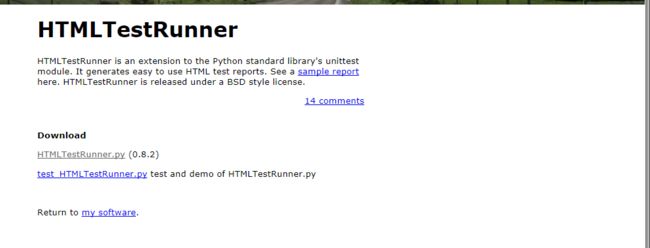【Python自动化测试】如何才能让用例自动运行完之后,生成一张直观可看易懂的测试报告呢?
小编使用的是unittest的一个扩展HTMLTestRunner
- 环境准备
使用之前,我们需要下载HTMLTestRunner.py文件
点击HTMLTestRunner后进入的是一个写满代码的网页,小编推荐操作:右键 --> 另存为,文件名称千万不要改
python3使用上述HTMLTestRunner可能会报错,可以替换如下文件
-
""" -
A TestRunner for use with the Python unit testing framework. It -
generates a HTML report to show the result at a glance. -
The simplest way to use this is to invoke its main method. E.g. -
import unittest -
import HTMLTestRunner -
... define your tests ... -
if __name__ == '__main__': -
HTMLTestRunner.main() -
For more customization options, instantiates a HTMLTestRunner object. -
HTMLTestRunner is a counterpart to unittest's TextTestRunner. E.g. -
# output to a file -
fp = file('my_report.html', 'wb') -
runner = HTMLTestRunner.HTMLTestRunner( -
stream=fp, -
title='My unit test', -
description='This demonstrates the report output by HTMLTestRunner.' -
) -
# Use an external stylesheet. -
# See the Template_mixin class for more customizable options -
runner.STYLESHEET_TMPL = '' -
# run the test -
runner.run(my_test_suite) -
------------------------------------------------------------------------ -
Copyright (c) 2004-2007, Wai Yip Tung -
All rights reserved. -
Redistribution and use in source and binary forms, with or without -
modification, are permitted provided that the following conditions are -
met: -
* Redistributions of source code must retain the above copyright notice, -
this list of conditions and the following disclaimer. -
* Redistributions in binary form must reproduce the above copyright -
notice, this list of conditions and the following disclaimer in the -
documentation and/or other materials provided with the distribution. -
* Neither the name Wai Yip Tung nor the names of its contributors may be -
used to endorse or promote products derived from this software without -
specific prior written permission. -
THIS SOFTWARE IS PROVIDED BY THE COPYRIGHT HOLDERS AND CONTRIBUTORS "AS -
IS" AND ANY EXPRESS OR IMPLIED WARRANTIES, INCLUDING, BUT NOT LIMITED -
TO, THE IMPLIED WARRANTIES OF MERCHANTABILITY AND FITNESS FOR A -
PARTICULAR PURPOSE ARE DISCLAIMED. IN NO EVENT SHALL THE COPYRIGHT OWNER -
OR CONTRIBUTORS BE LIABLE FOR ANY DIRECT, INDIRECT, INCIDENTAL, SPECIAL, -
EXEMPLARY, OR CONSEQUENTIAL DAMAGES (INCLUDING, BUT NOT LIMITED TO, -
PROCUREMENT OF SUBSTITUTE GOODS OR SERVICES; LOSS OF USE, DATA, OR -
PROFITS; OR BUSINESS INTERRUPTION) HOWEVER CAUSED AND ON ANY THEORY OF -
LIABILITY, WHETHER IN CONTRACT, STRICT LIABILITY, OR TORT (INCLUDING -
NEGLIGENCE OR OTHERWISE) ARISING IN ANY WAY OUT OF THE USE OF THIS -
SOFTWARE, EVEN IF ADVISED OF THE POSSIBILITY OF SUCH DAMAGE. -
""" -
# URL: http://tungwaiyip.info/software/HTMLTestRunner.html -
__author__ = "Wai Yip Tung" -
__version__ = "0.8.2" -
""" -
Change History -
Version 0.8.2 -
* Show output inline instead of popup window (Viorel Lupu). -
Version in 0.8.1 -
* Validated XHTML (Wolfgang Borgert). -
* Added description of test classes and test cases. -
Version in 0.8.0 -
* Define Template_mixin class for customization. -
* Workaround a IE 6 bug that it does not treat -
%(heading)s -
%(report)s -
%(ending)s -
